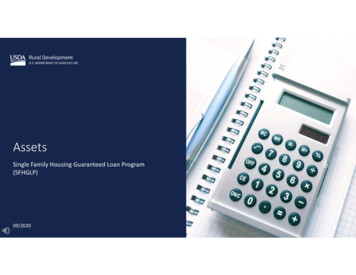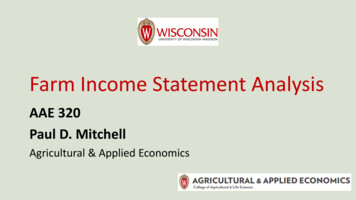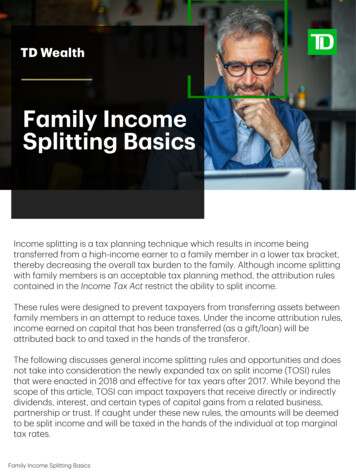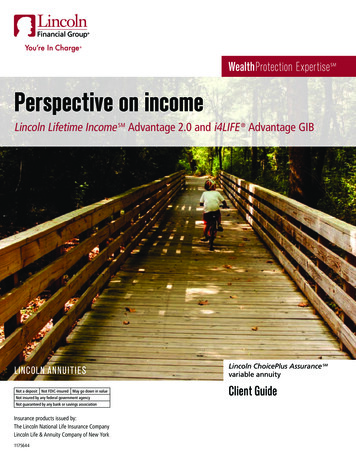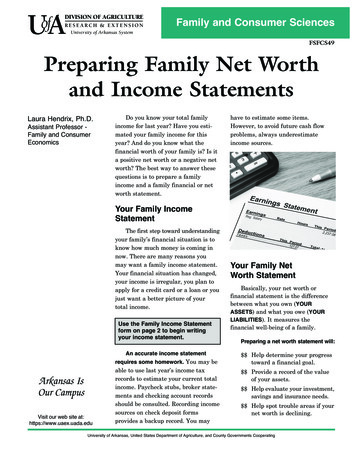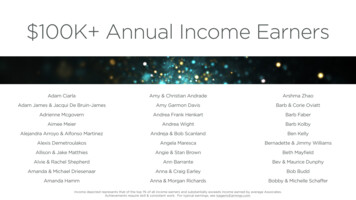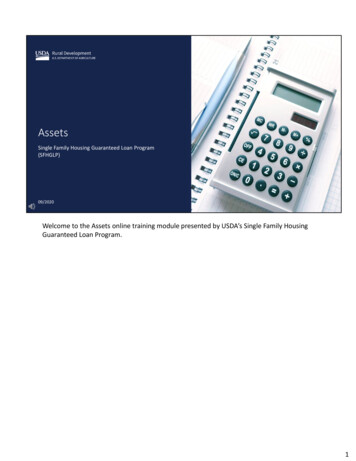
Transcription
Annual IncomeSingle Family Housing Guaranteed Loan ProgramAssetsSingle Family Housing Guaranteed Loan Program(SFHGLP)09/20201Welcome to the Assets online training module presented by USDA’s Single Family HousingGuaranteed Loan Program.1
ASSETS Verify Document Calculate2Assets are an important piece of an applicant’s financial puzzle. Understanding differentasset types and how they affect your applicant’s single-family housing guaranteed loan isessential. This module will assist you in determining how to verify and document assetsand how to calculate asset income when necessary.2
7 CFR Part 3555: 3555.152 (d)3 3555.152(d) requires net family assets of all household members (adults age 18 and up)to be included in the calculation of annual income. It is specifically the income derived from the net family assets that must be included inthe annual income calculation. This income may be derived from equity in real property, cash on hand and funds insavings and checking accounts, trust account funds available to the household, and nonretirement investments. Other net family assets that may derive income include lump sum amounts, personalproperty that is held as an investment, and any asset disposed of for less than fairmarket value during the preceding two years, unless the assets were disposed of as aresult of foreclosure, bankruptcy, divorce or separation settlement.3
7 CFR Part 3555: 3555.152 (d)4 3555.152(d)(2) lists net family assets that do not have to be considered in the annualincome calculation. These include assets such as cash on hand that will reduce the loan amount, personalproperty, and business assets. Other net family assets that are excluded when calculating annual income includevoluntary retirement accounts, cash value of life insurance policies, and any otheramount deemed by the agency not to constitute net family assets.4
7 CFR Part 3555: 3555.152 (d)When is an asset calculation required?5 An asset calculation must be performed when the household has cumulative net familyassets of 50,000 or more. If the total value of eligible assets is less than 50,000, then no calculation is required tobe added to the annual income calculation. If the total value is 50,000 or more, then the lender must use the greater of actualincome earned on the asset, or perform a calculation utilizing a passbook savings rate. An asset earning zero interest will require a local passbook savings rate.5
eview Attachment 9-APages 28-32Verify & DocumentCalculate Asset IncomeIf cumulative total is 50,000 or more6 To better assist with income review and documentation, Chapter 9 includes Attachment 9-A:“Income and Documentation Matrix.” The matrix was designed to assist lenders and USDA in efficiently locating many income sources,annual income adjustments, and asset guidance. Pages 28-32 specifically address Assets and Reserves. Under each asset type there are documentation options to assist the lender when obtaining acomplete loan file and to support their calculations. Please note that not every documentation item listed is required. USDA is providing flexibility to the lender to determine the best documentation option.6
7 CFR Part 3555: 3555.152 (d)Things to keep in mind: Income from eligible assets may berequired to be included in annual income. Assets are considered a compensatingfactor which do impact underwritingrecommendations in the GUS. Lenders will determine if assets are to beincluded in the underwriting analysis.7When reviewing the assets of an applicant and other adult household members pleasekeep the following in mind: Income from eligible assets may be required to be included in the annual incomecalculation. The technical handbook provides flexibility in asset amounts held by thehousehold to help determine when a calculation is required. Assets are important because they may be a compensating factor. Compensating factorsstrengthen the loan file and may affect underwriting recommendations rendered by GUS. Assets documented by the lender are not required to be included in the loan application.If a lender wishes to obtain a conservative underwriting recommendation or perform aconservative underwriting analysis, the assets do not have to be included on the loanapplication. However, the lender must include income from an asset in the annual incomecalculation, if applicable.7
Asset Verification is Always Required!Required (if over 50,000)Optional8 Lenders are not required to enter assets on the loan application or on the “Asset andLiabilities” page in GUS. Lenders may underwrite the loan or receive an automated underwritingrecommendation that does not consider the assets as a compensating factor. But when the assets exceed the acceptable threshold as indicated in the regulation andtechnical handbook then the income earned from the asset must be included on theincome worksheet submitted to USDA and on the GUS “Eligibility” page. It is important to be aware that asset verification is still required even when the amountfalls below the threshold requiring it to be used in GUS or entered into the URLA.8
7 CFR Part 3555: 3555.152 (d)Asset Inflation Invalid GUS underwritingrecommendations Invalid compensating factors Inaccurate annual incomecalculation Potential fraud9 When assets are utilized in GUS or in manual underwriting it is important that the assetsare not inflated. Inflated assets will result in: Invalid GUS underwriting recommendations, invalidcompensating factors, inaccurate annual income calculations, and potential fraud. When assets are inflated or incorrectly calculated to achieve a GUS Accept underwritingrecommendation or loan approval, it will impact the validity of the Loan NoteGuarantee, loss claim payment, etc.9
7 CFR Part 3555: 3555.152 (d)Example: Calculating Income from Assets Checking account (non‐interest bearing): 17,000 Savings account (.25% interest): 24,000 Certificate of Deposit (3% interest): 15,000Total Assets: 56,000 less 5,000 from checking used topurchase the homeRemaining Assets 51,00010 This is an example of when and how to calculate assets to be included in the totalhousehold annual income. This applicant has a non-interest bearing checking account with a balance of 17,000 aswell as a savings account that earns .25% interest annually with a balance of 24,000. The applicant also has a Certificate of Deposit that earns 3% annual interest with acurrent balance of 15,000. The applicant will use 5,000 from checking towards the purchase of the dwelling. The total of all eligible non-retirement assets is 56,000, minus the 5,000 that will beused to purchase the home, bringing the remaining balance of assets to 51,000. This is more than the 50,000 threshold, therefore an income calculation is required.10
7 CFR Part 3555: 3555.152 (d)Example (continued): Calculating Incomefrom Assets Checking: 17,000 ‐ 5,000 12,000 x .25% 30 Savings: 25,000 x .25% 62.50 CD: 15,000 x 3% 450Asset Calculation: 30 62.50 450 542.50Include 542.50 in annual income calculation11 Continuing with the example from the previous slide, the checking account isnon-interest bearing and will have 12,000 remaining after closing costs are deducted. We will assume the passbook savings rate for this example is .25%. This results in 30 of interest. The savings account is earning .25% interest, which equals 62.50 of interest. The CD will earn 450. Add these calculations together and you get 542.50 of interest income that must beincluded in the annual income calculation.11
7 CFR Part 3555: 3555.152 (d)Average Asset vs. Current Balance January Average Balance: 4,534.52 February Average Balance: 354.23 Current Balance: 1,456 Two-month Balance: 2,444.38Current Balance: 1,45612 When considering asset balances, any fluctuation should be evaluated carefully. In this example, the applicant had a balance of over 4,000 in January, the balance fellbelow 400 in February, and then increased to 1,456 for the current reported balance. The two-month average balance for January and February is 2,444.38, which is morethan the current balance of 1,456. The lessor of the two figures, in this case, 1,456, should be used.12
LEARNING CHECKS7 CFR Part 3555 / HB-1-355513The best way to learn information is to test your knowledge!13
QUESTIONTopic Question will be bulleted with scenario, or Include a statement/questionTRUE/FALSE or other answer options will be displayed14The following question slides will list: The topic, A question or scenario, and potential responses.14
ANSWERAnswer SlideTopic7 CFR Part 3555 and HB-1-3555 references providedX. Correct Response Additional guidance for clarification may be provided15The answer slides will list: The topic, the reference to the answer from the regulation and handbook, the correct response, and any additional clarification that may be helpful.15
Ready?LET’S GETSTARTED!16Let’s get started!16
QUESTIONAssetsWhich of the following assets may be required in the annual income calculation?SELECT ALL THAT APPLY:A. Checking accountB. Net proceeds from sale of current homeC. Certificate of deposit17Read the question on the slide and select a response.17
ANSWERAssets3555.152(d)(1), HB 9A. Checking accountB. Net proceeds from sale of current homeC. Certificate of depositAll of the above must be considered when determining the annual incomecalculation.18 Answer: All of the Above. Each of the assets listed must be considered when evaluating the total householdannual income.18
QUESTIONAssetsWhich assets are excluded from a conventional credit test?SELECT ALL THAT APPLY:A. Checking accountB. Antiques and collectiblesC. Savings accountD. 401k/Retirement accounts19Read the question on the slide and select a response.19
ANSWERAssets3555.152(d)(2), HB 9 B. Antiques/Collectibles D. Retirement PlanExclude personal property such as antiques and collectibles, as well asfunds in a voluntary retirement account.20 Answer: B and D For the purpose of calculating annual income, net family assets do not include the valueof necessary items of personal property nor do they include amounts placed in avoluntary retirement plans20
QUESTIONAssetsWhat is the asset threshold when a calculation is required for annual income?A. 5,000B. 20,000C. 50,000D. 10,00021Read the question on the slide and select a response.21
ANSWERAssets3555.152(d)(1), HB 9.4C. 50,000Net family assets of 50,000 or more must be reviewed for annual incomepurposes.22 Answer: C. 50,000 Household members with combined net family assets of 50,000 or more must havethose assets reviewed for annual income purposes. Lenders must review asset information provided by the applicant and other householdmembers at the time of loan application. Net family assets which have actual earnings will use the documented rate of interest tocalculate annual income. Net family assets that do not earn interest will use a current passbook savings rate tocalculate the annual income. Current passbook savings rates may be found through the lender’s own banking rates orby an online website for current savings rate in the area.22
QUESTIONAssetsLenders must enter all assets into the GUS “Assets and Liabilities” applicationpage and the 1003 loan application.A. TRUEB. FALSE23Read the question on the slide and select a response.23
ANSWERAssets3555.152(d)(1), HB 9B. FALSEAssets are not required to be entered in GUS or on the URLA if below theacceptable threshold24 Answer: B. False Lenders are not required to enter assets into the GUS or on the loan application. The lender may underwrite the loan or obtain an underwriting determination in the GUSwithout assets being included as a compensating factor. However, when the net family assets exceed the acceptable threshold as indicated inHB-3555, Section 9.4, then the income earned from the assets must be included asannual income. Again, it is important to note that the lender is always required to verify the assets,regardless of the amount or the exclusion in the GUS or on the URLA.24
QUESTIONAssets Checking: 1,500, non‐interest, local passbook savings rate is .25% Savings: 15,000, earns .50% annually Certificate of Deposit: 65,000, earns 2% annuallyWhat amount of income must be added to annual income?A. 1,378.75B. 025Read the question on the slide and select a response.25
ANSWERAssets3555.152(b)(4), HB 9A. 1,378.75 Assets are 50,000 or greater 1,500 x .25% (passbook rate) 3.75 15,000 x .50% 75.00 65,000 x 2% 1,300 3.75 75.00 1,300 1,378.7526 Answer: A The total assets are greater than 50,000. Therefore, the greater of the actual income earned or a local passbook savings rate mustbe used for the calculation. The 1,500 checking is non-interest bearing. Therefore the local passbook savings rate of .25% will be used, which equals 3.75 The 15,000 savings earns .50% for an annual total of 75.00 The 65,000 CD earns 2% for an annual amount of 1,300. Add these together for a total of 1,378.75. This amount must be included in thehousehold annual income.26
QUESTIONAssetsWhich of the following assets can be excluded when calculating annualhousehold income?SELECT ALL THAT APPLY:A. IRA AccountB. Money Market Savings AccountC. Trust Fund Controlled by Borrower’s GrandfatherD. 2,500 Lotto WinningsE. 50 Shares of Stock Interest27Read the question on the slide and select a response.27
ANSWERAssets3555.152(d)(2), HB 9A. IRA AccountC. Trust Fund Controlled by Borrower’s GrandfatherD. 2,500 Lotto WinningsExcluded assets include retirement accounts, trust funds that are not controlled bya household member, and lump sum/one-time payments that are nonrecurring.28 Answer: A. IRA Account, C. Trust fund controlled by borrower’s grandfather, and D. 2,500 lotto winnings. The IRA account is a retirement fund and therefore excluded from the incomecalculation. Trust funds that are not controlled by the household are also excluded because theborrower cannot actively access the funds at any time. Lump sum additions to the household assets that are nonrecurring are also notconsidered in the annual income calculation. The lender should review the bank statements to ensure that winnings from gambling,the lottery, or other such ventures are not occurring on a regular basis.28
Way to Go!LEARNING CHECKCOMPLETED!29Way to go! You have completed the learning checks!29
ram-regulationsNavigate through theseresources and tools likean ndbooksTake the “ProgramOverview Training”Available on the aining-resourcelibrary30 This training module has provided you with an overview of the key requirements of assets andasset income. Complete program requirements and guidance can be found in 7 CFR Part 3555, Subpart D,Section 3555.152(d) and Chapter 9, Paragraph 9.4 of HB-1-3555. Be sure to bookmark these references, save yourself valuable time by using Cntrl-F to quicklysearch and find answers, and always ensure you are referencing the most current publications. The “Program Overview Training” module will assist you in learning how to navigate through allthe resources and tools Rural Development has created to assist you.30
Can’t find youranswer in theregulation orhandbook?Contact the PACteam!Want additional liveprogram training?Contact the LPAteam!31 Users should first look for answers to their questions in the regulation and handbook,but if you still have a question after reviewing your resources, we’re here to help. All policy and regulation questions regarding the topic we just covered should be sent toour Policy, Analysis, and Communications Branch and If you would like to request additional program training, contact our Lender and PartnerActivities Branch.31
32Thank you for supporting the USDA Single Family Housing Guaranteed Loan Program and America’srural homebuyers!32
www.rd.usda.gov1 (800) 800-670-6553USDA is an equal opportunity provider, employer, and lender.33This will conclude the training module. Thank you and have a great day!33
Checking account (non ‐interest bearing): 17,000 Savings account (.25% interest): 24,000 Certificate of Deposit (3% interest): 15,000 Total Assets: 56,000 less 5,000 from checking used to purchase the home Remaining Assets 51,000 This is an example of when and how to calculate assets to be included in the total

